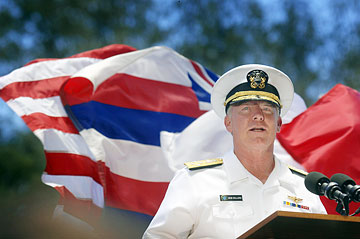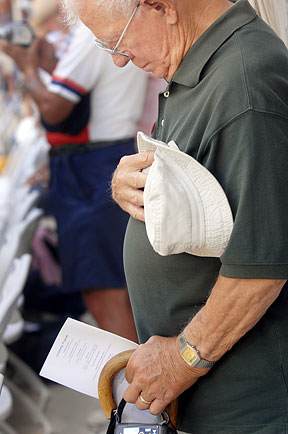HONOR IN SACRIFICE
 ASSOCIATED PRESS The population of Midway Atoll expanded from a handful to about 1,800 yesterday as top military and government officials mingled with veterans and family members from a special Princess Cruise Line ship to observe the 65th anniversary of the Battle of Midway. Pacific Fleet Commander Adm. Robert Willard spoke during the ceremony. CLICK FOR LARGE |
|
Remembering the Battle of Midway
Veterans and officials mark the turning point of World War II
By Audrey McAvoy
Associated Press
MIDWAY ATOLL » Holding their hands over their hearts, six elderly veterans of the Battle of Midway yesterday stood gingerly as a Navy band played "The Star-Spangled Banner" in honor of those who served with them in the fight that turned the tide of World War II 65 years ago.
Some 1,800 people ventured to the remote atoll 1,300 miles northwest of Honolulu to remember those who perished and those who survived, and to mark the day that put Japan on the defensive for the first time since the bombing of Pearl Harbor six months earlier.
"We salute the fallen warriors of the Battle of Midway. We remember their great victory and tremendous sacrifice," said Adm. Robert Willard, Pacific Fleet commander. "We honor them with our eternal vigilance and combat readiness."
WILLIAM TUNSTALL, 87, an aviation machinist's mate on the USS Hornet on June 4, 1942, said he felt lonesome as he sat remembering those who died in the battle.
Tunstall recalled helping the pilot and gunner of the torpedo plane he maintained climb aboard for their mission to bomb Japanese carriers that were approaching Midway.
But neither the pilot, Bill Abercrombie, nor the gunner, Bernie Phelps, ever returned to the Hornet. Of the 30 men in Torpedo Squadron 8 who took off on June 4, only one survived.
 ASSOCIATED PRESS John Howlett, 81, of Clovis, Calif., prayed during the anniversary observation yesterday. Howlett was 15 when he enlisted and was at Pearl Harbor when the survivors of the USS Yorktown came to Oahu. CLICK FOR LARGE |
|
"From the time they left the carrier to today, I have no way of knowing what happened to them," said Tunstall, of Portland, Ore. "I lost a lot of good friends."
Both sides suffered large losses. The United States saw 307 men perish and one aircraft carrier sink. It lost 145 planes.
Japan's casualties were even higher, with 4,800 men dying. All four of the aircraft carriers Tokyo sent to Midway sank, along with a heavy cruiser and three destroyers. Japan also suffered the loss of 291 planes.
Japan's navy wanted to take over the strategically important atoll to protect its homeland from U.S. air raids and prevent the U.S. from interfering in its campaign to dominate the Asia-Pacific region. Victory would have given Japan control over the patrol plane base there and possibly cleared the way for an invasion of the main Hawaiian Islands and attacks on the West Coast.
TODAY, MIDWAY is part of a wildlife reserve run by the U.S. Fish and Wildlife Service.
Hundreds of thousands of Laysan albatross, or gooney birds, nest there while endangered Hawaiian monk seals and threatened green sea turtles frequent the clear blue waters of its lagoon.
Only a few dozen people, wildlife reserve researchers and support staff live on Midway now.
The cruise ship bringing veterans from Los Angeles and the chartered plane both had to obtain special permits to visit Midway because of the atoll's location in the Papahanaumokuakea Marine National Monument.

